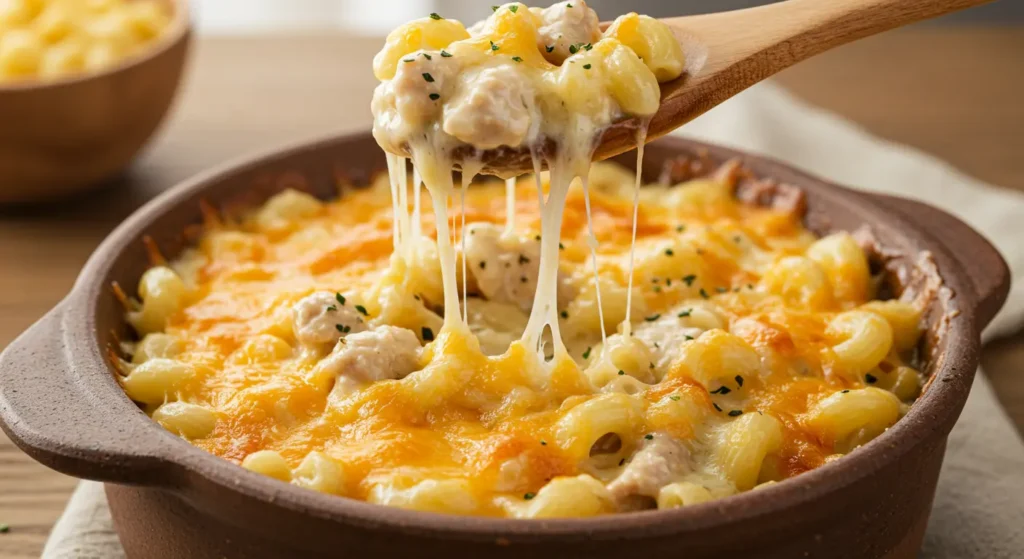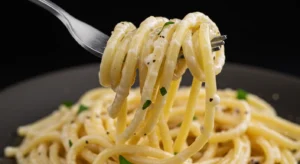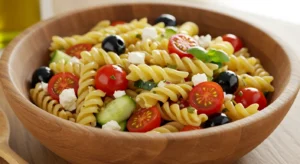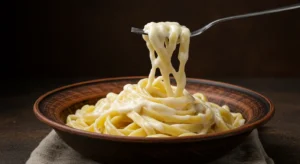Turkey Mac – Why This Recipe?
As Chef Greeny, I’ve always had a special place in my heart for comfort food classics with a healthy twist. My journey with turkey mac and cheese began during my college years when I was looking for ways to make my favorite childhood dish a bit more nutritious without sacrificing flavor. What started as a simple substitution—swapping traditional ground beef for lean ground turkey—evolved into one of my signature dishes that I’m excited to share with you today.
Growing up in a household where mac and cheese was a weekly staple, I learned that this dish is more than just food—it’s a warm hug in a bowl. However, as I became more conscious about balancing comfort with nutrition, turkey mac became my go-to solution. The lean protein from the turkey combines perfectly with the creamy cheese sauce, creating a dish that’s both satisfying and slightly less indulgent than traditional mac and cheese.
What makes this recipe special is my secret blend of seasonings and cooking techniques that ensure the turkey remains juicy while infusing maximum flavor into every bite. I’ve also included some unique twists that elevate this dish from a simple weeknight dinner to something you’d be proud to serve at a gathering with friends and family.
In this post, you’ll learn not just how to make an incredible turkey mac and cheese from scratch, but also how to customize it for different dietary needs, the history behind this comfort food fusion, and answers to all your burning questions about perfecting this dish. Whether you’re a novice in the kitchen or an experienced home cook, my step-by-step instructions will help you create a turkey mac that will have everyone asking for seconds!
Turkey Mac – Ingredients and Preparation
Ingredients List
For the Turkey Component:
- 1 pound ground turkey (93% lean)
- 1 tablespoon olive oil
- 1 medium yellow onion, finely diced
- 3 cloves garlic, minced
- 1 tablespoon Italian seasoning
- 1 teaspoon smoked paprika
- ½ teaspoon red pepper flakes (optional)
- Salt and freshly ground black pepper to taste
For the Mac and Cheese:
- 16 ounces elbow macaroni (or pasta of choice)
- 3 tablespoons unsalted butter
- 3 tablespoons all-purpose flour
- 2½ cups whole milk
- 1 cup chicken broth (low sodium)
- 2 cups sharp cheddar cheese, freshly grated
- 1 cup Monterey Jack cheese, freshly grated
- ½ cup Parmesan cheese, freshly grated
- ¼ teaspoon ground nutmeg
- 2 teaspoons Dijon mustard
For the Topping (Optional):
- 1 cup panko breadcrumbs
- 2 tablespoons melted butter
- ¼ cup Parmesan cheese, grated
- 1 tablespoon fresh parsley, chopped
Substitution Options:
- Gluten-Free: Use gluten-free pasta and replace all-purpose flour with a 1:1 gluten-free flour blend
- Dairy-Free: Substitute milk with unsweetened almond milk or oat milk; use dairy-free cheese alternatives
- Lower Calorie: Use 99% lean ground turkey and reduced-fat cheeses
- Vegetarian: Replace ground turkey with plant-based ground meat alternative or 2 cups of roasted vegetables (cauliflower, mushrooms, and bell peppers work well)
Step-by-Step Instructions
- Prepare the pasta: Bring a large pot of salted water to a boil. Cook the macaroni according to package directions until al dente (typically 7-8 minutes). Drain and set aside, reserving ½ cup of pasta water. Chef’s Tip: Cook the pasta 1-2 minutes less than the package suggests as it will continue cooking in the sauce later.
- Cook the turkey: While the pasta is cooking, heat olive oil in a large skillet over medium-high heat. Add the diced onion and cook until translucent, about 3-4 minutes. Add minced garlic and cook for another 30 seconds until fragrant. Chef’s Tip: Don’t brown the garlic or it will become bitter.
- Season the meat: Add the ground turkey to the skillet, breaking it up with a wooden spoon. Season with Italian seasoning, smoked paprika, red pepper flakes (if using), salt, and pepper. Cook until the turkey is completely browned and no longer pink, about 5-7 minutes. Chef’s Tip: For extra flavor, deglaze the pan with 2 tablespoons of white wine or chicken broth after the turkey is cooked.
- Start the cheese sauce: In a separate large pot or Dutch oven, melt the butter over medium heat. Add the flour and whisk continuously for 1-2 minutes to create a roux, being careful not to let it brown. Chef’s Tip: The roux should be the color of wet sand – if it’s too dark, your sauce might have a burnt flavor.
- Create the creamy base: Slowly pour in the milk and chicken broth, whisking constantly to prevent lumps. Continue whisking until the mixture begins to thicken, about 3-5 minutes. Chef’s Tip: Warm your milk slightly before adding it to the roux for a smoother sauce.
- Add the cheese: Reduce heat to low and gradually add the grated cheddar, Monterey Jack, and ¼ cup of the Parmesan cheese, stirring until completely melted and smooth. Add the nutmeg and Dijon mustard, then taste and adjust seasonings if needed. Chef’s Tip: Always grate your own cheese rather than using pre-shredded, which contains anti-caking agents that can prevent smooth melting.
- Combine components: Add the cooked turkey mixture and drained pasta to the cheese sauce. Stir gently to combine, adding a splash of reserved pasta water if the mixture seems too thick. Chef’s Tip: The starchy pasta water helps bind the sauce to the pasta for a silky finish.
- Prepare for baking (optional): If you prefer a baked version, transfer the mixture to a greased 9×13-inch baking dish. In a small bowl, combine the panko breadcrumbs, melted butter, remaining Parmesan cheese, and chopped parsley. Sprinkle evenly over the top. Chef’s Tip: For extra crispiness, place the baking dish under the broiler for the last 2-3 minutes, watching carefully to prevent burning.
- Bake (optional): Bake in a preheated 375°F oven for 20-25 minutes until the top is golden brown and the edges are bubbly. Chef’s Tip: Let the baked turkey mac rest for 5-10 minutes before serving to allow the sauce to set.
- Serve: Garnish with additional fresh herbs if desired and serve hot.
Notes and Tips
Storage Tips:
- Refrigerator: Store leftover turkey mac in an airtight container for up to 3-4 days.
- Freezer: This dish freezes well for up to 3 months. Portion into freezer-safe containers, cool completely before freezing, and label with the date.
- Reheating: For best results when reheating, add a splash of milk or chicken broth to prevent the pasta from drying out. Microwave on medium power, stirring occasionally, or reheat in a covered dish in a 350°F oven until warmed through.
Serving Suggestions:
- Pair with a simple side salad dressed with lemon vinaigrette for a complete meal.
- Serve alongside roasted vegetables like broccoli, Brussels sprouts, or asparagus.
- For a casual gathering, offer garlic bread or dinner rolls on the side.
Make-Ahead Instructions:
- Prepare the entire dish up to the baking step, cover, and refrigerate for up to 24 hours.
- When ready to serve, let sit at room temperature for 30 minutes before baking, and add an extra 5-10 minutes to the baking time.
- The turkey component can be cooked up to 2 days in advance and stored separately in the refrigerator.
Turkey Mac – Nutritional Information
Nutrition Facts (Per Serving)
Based on 8 servings
| Nutrient | Amount |
|---|---|
| Calories | 510 |
| Carbohydrates | 43g |
| Protein | 31g |
| Total Fat | 25g |
| Saturated Fat | 13g |
| Unsaturated Fat | 10g |
| Trans Fat | 0g |
| Fiber | 2g |
| Sugar | 5g |
| Cholesterol | 95mg |
| Sodium | 560mg |
Nutritionist’s Note: Turkey mac and cheese offers significantly more protein and less saturated fat than traditional mac and cheese made with beef. For an even healthier version, try using whole wheat pasta to increase the fiber content and consider reducing the cheese by 25%.
Turkey Mac – History and Cultural Significance
Mac and cheese has a rich history dating back to at least the 14th century, with the first recorded recipe appearing in an Italian cookbook called “Liber de Coquina.” However, the dish as Americans know it today gained popularity in the United States thanks to Thomas Jefferson, who encountered pasta during his time in France and brought a pasta machine back to America. The combination of macaroni and cheese became a staple in American cuisine, appearing in cookbooks by the late 19th century.
The addition of ground meat to mac and cheese is a distinctly American innovation that emerged during the mid-20th century as a way to create a more substantial one-dish meal. Ground beef was traditionally the protein of choice, appearing in many casserole recipes during the post-war era when convenience cooking became increasingly popular.
The shift toward using ground turkey as a healthier alternative gained momentum in the 1980s and 1990s when nutritional awareness increased and many Americans began seeking ways to reduce fat and cholesterol in their diets. Turkey mac represents the perfect fusion of comfort food tradition with modern health consciousness—maintaining the satisfying qualities of the original dish while incorporating leaner protein.
Regionally, you’ll find interesting variations of meat-enhanced mac and cheese:
- In the Southern United States, mac and cheese might include smoked turkey or ham
- In the Southwest, you might find turkey mac and cheese with green chilies, corn, and Mexican-inspired seasonings
- In New England, seafood mac and cheese with lobster or crab is popular, though some versions include turkey as well
Similar dishes from other cuisines include Greek pastitsio (a baked pasta dish with ground meat and béchamel sauce) and British cottage pie topped with cheesy mashed potatoes instead of pasta.
Turkey Mac – Creative Variations
1. Mediterranean Turkey Mac
Transform your turkey mac into a Mediterranean delight with these modifications:
- Add 1 cup of chopped sun-dried tomatoes and ½ cup of pitted kalamata olives to the turkey while cooking
- Mix in 1 cup of fresh baby spinach just before combining with the pasta
- Replace the Italian seasoning with 2 teaspoons of dried oregano and 1 teaspoon of dried basil
- Substitute feta cheese for the Monterey Jack
- Garnish with fresh chopped parsley and a squeeze of lemon juice before serving
Nutrition adjustment: This version adds approximately 45 calories per serving with increased micronutrients from the vegetables.
2. Low-Carb Cauliflower Turkey Mac
Perfect for those following a keto or low-carb diet:
- Replace the pasta with 6-8 cups of cauliflower florets, steamed until just tender
- Increase the cheese amounts by ¼ cup each for a more substantial sauce
- Add ¼ teaspoon xanthan gum to the sauce to help thickening (optional)
- Include 4 oz of cream cheese in the sauce for added creaminess
- Top with crushed pork rinds instead of breadcrumbs for a crispy, carb-free topping
Nutrition adjustment: Reduces carbohydrates to approximately 12g per serving while increasing fat content to about 32g per serving.
3. Spicy Buffalo Turkey Mac
For those who enjoy a kick of heat:
- Add ⅓ cup of buffalo sauce to the ground turkey after it’s cooked
- Mix in 1 diced bell pepper and 1 diced celery stalk with the onions
- Add 1 cup of blue cheese crumbles instead of (or in addition to) some of the cheddar
- Top with sliced green onions and a drizzle of ranch or blue cheese dressing before serving
- For extra heat, add 1 diced jalapeño with the vegetables
Dietary adaptation tip: For a lighter version, use light blue cheese and reduced-fat ranch dressing.
Turkey Mac – Frequently Asked Questions
Can I freeze turkey mac and cheese?
Yes, turkey mac and cheese freezes excellently for up to 3 months! For best results, slightly undercook the pasta before assembling, as it will soften further when reheated. Allow the dish to cool completely before transferring to freezer-safe containers. I recommend freezing in individual portions for easier reheating. When ready to eat, thaw overnight in the refrigerator and reheat in the oven at 350°F for about 20-25 minutes, or until heated through. Add a splash of milk if it seems dry during reheating.
What can I substitute for the cheeses in this recipe?
The cheese combination in this recipe creates the perfect balance of flavor and meltability, but you can certainly substitute based on what you have available:
- Instead of sharp cheddar: Colby, Gruyère, or medium cheddar
- Instead of Monterey Jack: Mozzarella, provolone, or Gouda
- Instead of Parmesan: Pecorino Romano, Asiago, or nutritional yeast (for a dairy-free option)
For dairy-free versions, cashew-based or oat-based cheese alternatives typically melt better than coconut-based ones. Just be aware that substitutions may alter the final texture and flavor of the dish.
How long does it take to prepare turkey mac from start to finish?
The total time from start to finish is approximately 45-60 minutes:
- Prep time: 15 minutes for chopping and measuring ingredients
- Cooking time: 30 minutes for cooking the turkey, making the cheese sauce, and boiling the pasta
- Baking time (if using the optional baked version): 20-25 minutes
If you’re short on time, you can skip the baking step and serve the stovetop version immediately after combining the pasta, turkey, and cheese sauce. This cuts the total time to about 30-40 minutes.
Can I make turkey mac and cheese in advance for a party?
Absolutely! Turkey mac and cheese is an excellent make-ahead dish for entertaining. Prepare the recipe up to the point of baking, then cover and refrigerate for up to 24 hours. When you’re ready to serve, let the dish sit at room temperature for about 30 minutes, then bake at 375°F for 25-30 minutes until hot and bubbly.
If you need to prepare even further in advance, assemble the dish completely, cover tightly, and freeze. Thaw overnight in the refrigerator before baking, adding about 10-15 minutes to the baking time. For the freshest taste, prepare the breadcrumb topping just before baking rather than freezing it on top of the dish.
Is turkey mac and cheese healthy?
Turkey mac and cheese is a healthier alternative to traditional mac and cheese with beef, but it’s still a comfort food that should be enjoyed in moderation as part of a balanced diet. The use of lean ground turkey instead of beef reduces the saturated fat content significantly. One serving provides approximately 31g of protein, which is excellent for muscle maintenance and satiety.
To make this dish even healthier:
- Use whole wheat pasta to increase the fiber content
- Reduce the cheese by 25% and increase the seasonings to maintain flavor
- Add more vegetables like spinach, peas, or broccoli
- Use low-fat milk instead of whole milk
- Serve smaller portions alongside a large salad or roasted vegetables
Turkey Mac – Final Thoughts
Turkey mac and cheese represents the perfect balance between comfort food indulgence and mindful eating. By incorporating lean ground turkey into this classic dish, we not only add valuable protein but also create a more satisfying and nutritionally balanced meal that can be enjoyed without guilt. Throughout this article, we’ve explored the origins of this comforting combination, detailed step-by-step instructions for creating the perfect turkey mac, and provided variations to suit different tastes and dietary needs.
What makes this dish so special is its versatility—whether you’re cooking for picky children, health-conscious adults, or guests with specific dietary restrictions, turkey mac can be adapted to please virtually anyone at your table. The basic cooking techniques remain the same, but the flavor possibilities are endless when you experiment with different cheeses, seasonings, and add-ins.
I encourage you to make this recipe your own! Start with the classic version, then get creative with the variations suggested or invent your own unique twist. The beauty of comfort food is that it connects us to memories and traditions while still leaving room for innovation and personal preference.
Have you tried making turkey mac and cheese before? Do you have a special ingredient or technique that makes your version unique? Leave a comment with your favorite variation or share your results after trying this recipe. Your feedback and creative ideas help our cooking community grow and inspire others to experiment in the kitchen!







